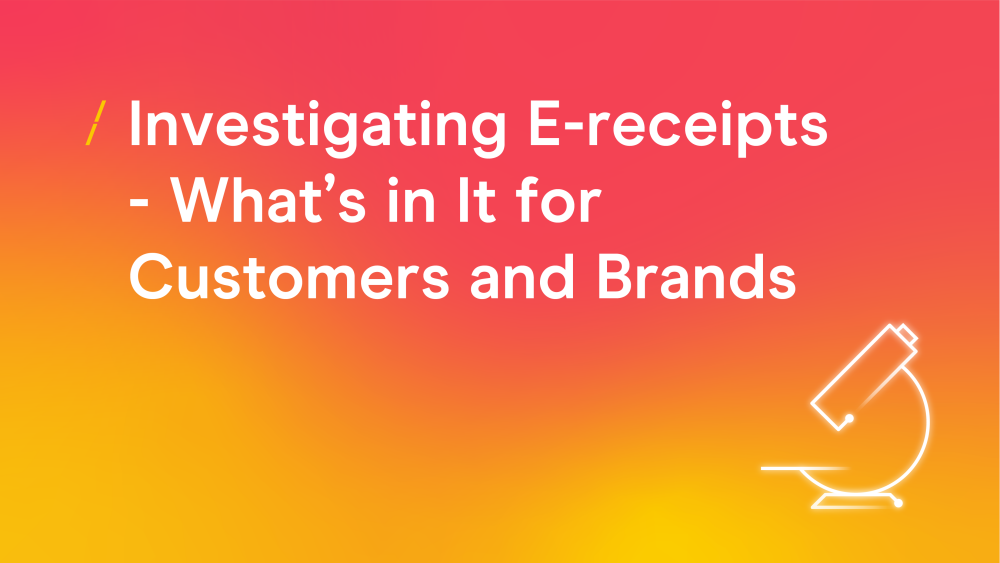Investigating E-receipts - What's in It for Customers and Brands
22 Mar 2021

This article is written by Konstantinos Karagkounis, Deliverability Operations Lead at Emarsys and member of the Research Hub of the DMA Email Council .
An electronic receipt, or e-receipt, is a proof of purchase for paid goods or services issued instead of the paper receipt, and is usually delivered via email or in-app.
Why do consumers like e-receipts? How can they benefit businesses too? What barriers should organisations be aware of and how can they overcome them?
In this article you will read about e-receipts as a powerful tool that can really transform and boost your business.
While we, as consumers, are educated in digital customer experiences, it seems that some retailers are not paying enough attention to the ongoing user transformation from the classic to the digital consumer.
Many suppliers have just started using the standardised e-invoicing while other sectors, like utilities, have switched completely to digital invoices for their customers. For instance, Amazon stores its invoices or receipts in a digital format, which could be viewed or downloaded at any time. Even governmental official documents can be requested and are offered online.
So, why is offering electronic receipts a good idea for your business?
It’s all about improving your customers’ experience and, more precisely, bettering the experience of your already digitally savvy customers.
There are several reasons why consumers like e-receipts:
- Digital warranties: Your customers will have the option to get and store the products’ warranty in a digital format and be able to claim it in a much simpler way
- Offer loyalty cards: Thanks to better data insight and segmentation strategies, businesses can better understand customers and engage them in ways that drive long-term loyalty
- Faster checkout times: It is all about efficiency and minimising waiting in lines!
- Connection with tax authorities: E-receipts can be accepted and used for tax purposes
- Expenses management and tracking: Easily track expenses from your inbox or with newer apps that allow consumers to link e-receipts to their bank account (like this one from Barclays)
- Customer data and insights: Through surveys, for example a post-purchase satisfaction survey, brands can collect valuable feedback on the whole customer experience and potential pain points
What’s in it for your business? There are many benefits and opportunities e-recepits can offer:
- Better performance: Data from the DMA’s ‘Consumer Email Tracker 2020’ report revelead that 58% od respondents felt trust and found convenience in receiving emails containing e-receipts
- Increase contact acquisition: E-receipts have become the most used tactic for brands to rebuild their databases/CRMs post GDPR
- Insights on consumers’ offline shopping habits: Even if you are using a multi- or omni-channel marketing strategy, it’s key to have data and isights about customers’ in-person shopping happening on site
- E-trust: You create a relationship with offline customers and encourage them to re-purchase/visit brand’s online sites
- Reducing checkout queues: For your staff and customers’ security, especially during these difficult times, it’s important to reduce queues and allow for social distancing
- Reducing carbon footprint: Globally, businesses are moving towards more eco-friendly operations and some countries are considering abandoning paper receipts (a few relevant reads for you: link, link2, link3) as the way to go in the future
Despite all the benefits, a few factors might hold decision-makers back and ultimately impact take-up of e-receipts. These include:
- Change resistance: Businesses can be averse to change and see early adoption as a risk
- Data privacy concerns: What, how and why data is being collected are important questions, but they can be seen as legislative barriers and risks too
- E-fraud/cyber-attacks: e-receipts are easy to share, can be changed and could be susceptible to forgery; for example, retailers could become targets of organised retail crime if customers share and alter digital receipts
- Initial investment: Setting any new technology up requires investment of time, resource and budget – from planning through to the software and hardware to implement it
And finally, a few tips to optimise your e-receipts plan and set-up process:
- Have a clear process in place
- Use known technology solutions available in the market
- Use email address validators upon data input to have a clean list
- Have a confirmed opt-in (COI) process
- Soft opt-in
- Educate both your employees why e-receipts are useful for customers
- Educate your customers by demonstrating the added value of e-receipts
- Explain to customers why emails are being sent to them
- Inform your customers for their right to opt-out at any time
- Use the e-receipt to obtain marketing consent
Curious to learn more on e-receipts? Have a look at these two other articles:
Investigating Email: E-reciepts
Investigating E-receipts - The Opportunities for Brands




Please login to comment.
Comments